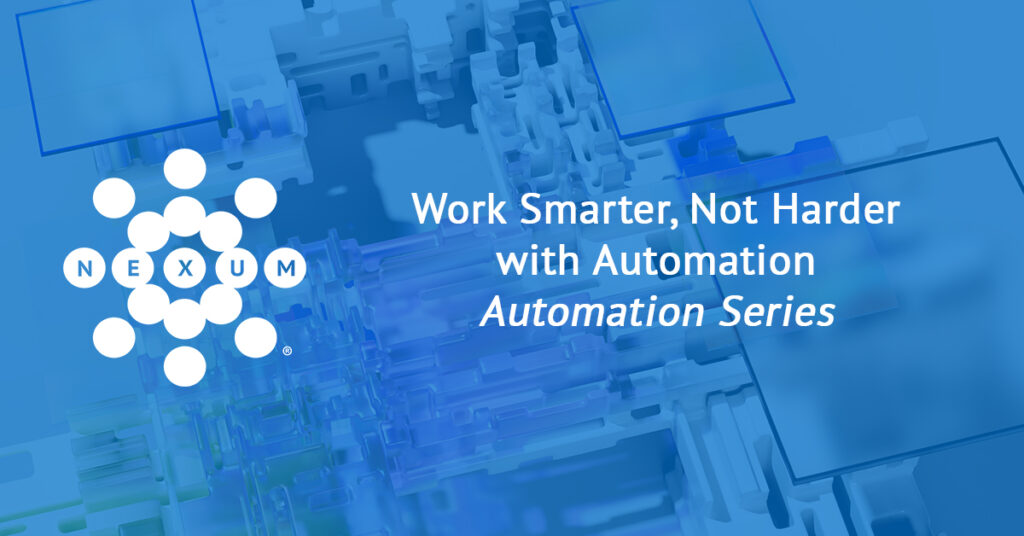
Work Smarter, Not Harder with Automation
Automation Series
Written by: Cory Kramer, Nexum Principal Engineer
Connect with Cory on LinkedIn
Welcome to a new series of Nexum blog posts where we dig into the world of automation and how it can help organizations operate more efficiently. While automation has been around for a long time in areas such as manufacturing, logistics, and critical infrastructure, we now see significant adoption of automation in technology services. This series will focus on IT automation and how it can help organizations with the familiar desire to “do more with less.” There are many different use cases for IT automation, but the goal is typically to replace repeatable processes while reducing time-consuming and costly manual human intervention. There are always reports of insufficient skilled IT workers, organizations with technical debt, and workers losing interest in repetitive tasks. Modern IT automation can help overcome some of these challenges.
Automation… It’s So Hot Right Now
The ability to script and write code is a concept that has long been familiar to many areas of IT. We knew about the efficiencies we could gain in the long-term by spending time upfront writing code, but there wasn’t always an easy way to understand the costs involved or the return on investment. As the popularity of cloud computing increased, organizations started their public cloud journey by treating resources as “always on,” similar to their traditional on-premises resources. This led to sticker shock when receiving the bill for cloud consumption. Organizations quickly realized the financial cost of utilizing the cloud and needed to find better ways to optimize costs and manage resources. There are too many benefits of leveraging public cloud to list, and balancing cost with utilization became a big driver for adopting IT automation. The ability to quickly and repeatably set up and tear down cloud resources allows organizations to benefit from the elasticity of the cloud while managing their costs properly.
Automation Helps Applications
As time went on and cloud adoption increased, we realized that traditional on-premises tools and technologies we leveraged didn’t always fit architecturally or scale well in the public cloud. We also needed a way for tools and systems to communicate easier and in a standardized way. Manufacturers now provide application programming interfaces (APIs) to configure and manage the systems instead of closed or proprietary means of access. Leveraging APIs is now pervasive among IT administrators, and we can easily communicate between many different systems and even orchestrate complex use cases. DevOps has become a standard technical process for unifying software development (Dev) with Operations (Ops). APIs and DevOps go hand in hand as DevOps processes can optimize the management of APIs.
Automation Helps Infrastructure
I recall about 15 years ago working as a network engineer for an enterprise organization on a project to replace over 1,000 branch locations with new network routers and switches. We spent significant time creating a spreadsheet with variables like hostnames and IP addresses. Back then, we wrote a Visual Basic Script to pull from those fields individually to create a unique configuration file for each router and switch. We saved considerable time and the risk of human error. We didn’t have an official industry term for this then, but now many more tools allow provisioning and de-provisioning of what’s known as Infrastructure as Code (IaC). We also have more robust tools for configuration management, templating, and packaging today.
Automation Helps Security
As time passes, the sophistication of malicious threats continues to increase, as does the need for talented security professionals to defend against them. The tools we have today can provide layers of defense, but we often find that systems don’t always integrate seamlessly or share threat information easily. For security operations teams to keep up with defending against modern threats, we must work towards automating security. The good news is that manufacturers are building these capabilities in their solutions today. For example, we can leverage a security orchestration automation and response (SOAR) solution to gather information from tools and provide an actionable response to threats. This alleviates the manual burden of security operations teams and allows them to focus on essential tasks that aren’t easily automated. We also can automate many other security-related tasks, such as threat hunting and incident management.
What’s Next?
Above, we briefly discussed some use cases for automation. Cloud resource management allows organizations to control costs and rapidly provision services. APIs allow different systems to interact quickly and efficiently through automation. Infrastructure as code paves the way for standardized, predictable, and rapid physical and virtual infrastructure deployment. Configuration management ensures that systems are compliant with required organizational settings and standards. We also discussed how automation could help remove some manual burdens from security teams. Organizations are leveraging automation to work smarter, not harder, in many ways. Stay tuned as we go deeper into the technical details and more, in future blog posts in our Automation Series.
The Nexum solutions team can help your organization leverage the power of automation and orchestration. Please be sure to use our Talk With An Expert form here so we can help you achieve many of the use cases for automation.
Check Out More Resources

Juniper EX4000
Nexum’s, Allyn Crowe, breaks down what sets the latest EX4000 series switch apart—powerful PoE, multigig support for next-gen Wi-Fi, and faster performance. With quick boot times and seamless upgrades, it’s a smart choice for future-proofing networks.

Juniper Announces Wi-Fi 7 Access Points
Nexum’s engineering team highlights Juniper’s new Wi-Fi 7 AP47 as a game-changer, offering faster speeds, quad radios, and enhanced IoT capabilities. With dual 10Gbps interfaces and AI-driven Wi-Fi 7 support, these access points are designed for cutting-edge network performance.

AI-Native Now
Join Juniper Networks on June 5th for a LinkedIn Live exclusive discussion on “Leveraging AIOps for Maximum Impact.”


